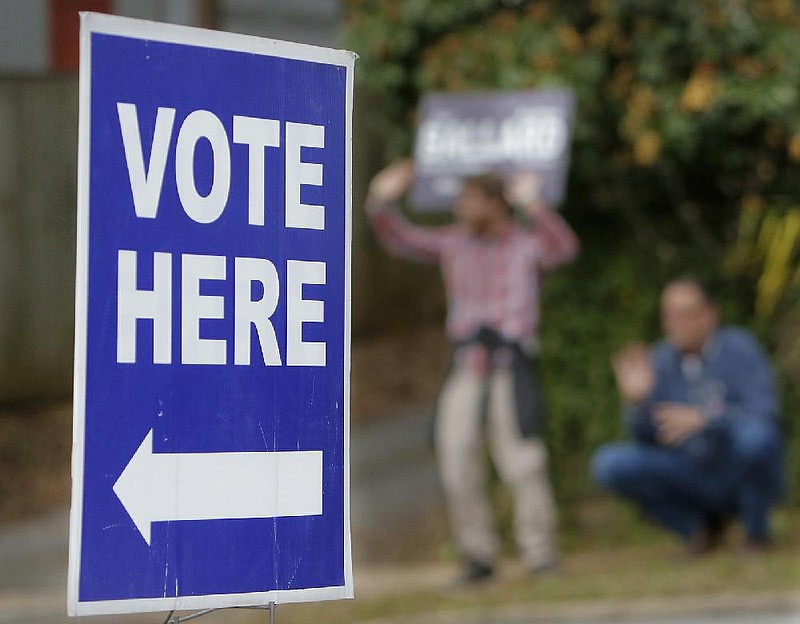An 8-month-old lawsuit challenging the legality of Arkansas' ballot-counting machines was thrown out of court on Monday after the plaintiff's attorney said he could not show that the system has ever misrepresented a vote.
At issue was whether the bar code-based system allows voters "to verify in a private and independent manner the votes selected by the voter on the ballot before the ballot is cast" as described in Arkansas Code 7-5-504, which sets the standards for machine operations under the state Election Code.
Dismissing the lawsuit, Circuit Judge Tim Fox ruled that the system does provide that verification opportunity as required by law because voters are given printed ballots to cast once they've selected their choices from the computer system.
"This format completely and totally complies with that [language]," he said. "They [voters] got to look at that information. The voter has been given the opportunity to confirm their ballot."
The law is "clear and unambiguous" so the question comes down to either yes, the system complies with the law, or no, it does not, the judge said.
"This is the crux of the lawsuit," Fox said. "I am ruling that ... this mechanism gives the voter the opportunity to verify in a private and independent manner the votes selected by the voter on the ballot before the ballot is cast."
Generally, Arkansas voters mark their ballots through a computer screen, which then prints out paper ballots showing voters' selections expressed both in writing and through a bar code. Voters then cast their vote by placing that printed document, their legal ballot, into the vote-counting tabulator.
Conrad Reynolds of Conway, head of the lobbying group Arkansas Voter Integrity Initiative, filed the lawsuit in December. Reynolds' group has been advocating for Arkansas counties to switch to hand-marked and hand-counted ballots.
An unsuccessful Republican candidate for the U.S. House, Reynolds sued Republican Secretary of State John Thurston and the State Board of Election Commissioners, along with the ExpressVote machines' maker Election Systems and Software LLC of Nebraska, claiming that the system's reliance on bar codes means that voters cannot independently verify whether their ballot reflects their intentions.
Fox's ruling came after Reynolds' attorney Clint Lancaster had presented only his first witness, Daniel Shults, director of the State Board of Election Commissioners, who described how voters cast ballots.
Lancaster, who had intended to call as many as eight more witnesses, was surprised by the judge's decision that he did not need to hear any more before dismissing the case.
"I am a bit troubled because I have just called one witness and I haven't put on my entire case," Lancaster told the judge.
Fox said that he had accepted and considered his argument that voters cannot read bar codes.
"I'm not meaning to cut you off ... but what else were they going to testify to? It seems to me that it all comes back to the common person can't read bar codes. I am a common person and I can't read bar codes," the judge said.
Questioned by the judge, Lancaster conceded he has no proof that any Arkansas voter's ballot has been wrongly labeled. Lancaster said he does have evidence that the computer system is flawed and vulnerable to "hacking."
"I have evidence that there's a design flaw," the attorney said. "I have two experts who will testify that the software is capable of being exploited in such a manner that the voter cannot trust the bar code ... is accurate."
But Lancaster's suit only addresses what happens with ballots between the time when they are printed from the voting machine until they are cast, which is when the ballot is entered into the tabulator, the judge said. That time is when voters get to review their ballots like the law says, the judge said.
What happens after votes are cast is a separate issue that Lancaster had not raised, Fox said.
"The specific statutory challenge is [what happens] before the ballot was cast, not that something's happened with the network after," Fox said.
Lancaster further accused the judge of deciding the case without hearing all of his evidence and called on Fox to recuse, which the judge declined.
"You appear to have already ruled without hearing my evidence," he told the judge. "It sounds like at this point, you've already made up your mind."
With no evidence the system hasn't worked, Fox said he was not going to consider "some hypothetical testimony about something that may have happened in some other state."
"It's an issue of law ... you're trying a completely different case than what you've asked for. You're acting as if you have testimony and evidence that affects your challenge [to the law] and you don't," Fox said. "What you want to do is introduce a lot of evidence having nothing to do with what you [claimed in the lawsuit]. What you are saying now is that there are some flaws or weaknesses ... in using these electronic machines that don't have anything to do with whether the voter had a chance to review their ballot."
